PNNL-led researchers: Conditions that started decades ago are changing forests and are likely to continue.
Ongoing environmental changes are transforming forests worldwide, resulting in shorter and younger trees with broad impacts on global ecosystems, scientists say.
In a global study published in the May 29 issue of Science magazine, researchers led by the U.S. Department of Energy’s Pacific Northwest National Laboratory found that rising temperatures and carbon dioxide have been altering the world’s forests through increased stress and carbon dioxide fertilization and through increasing the frequency and severity of disturbances such as wildfire, drought, wind damage, and other natural enemies. Combined with forest harvest, the Earth has witnessed a dramatic decrease in the age and stature of forests.
“This trend is likely to continue with climate warming,” said Nate McDowell, a PNNL Earth scientist and the study’s lead author. “A future planet with fewer large, old forests will be very different than what we have grown accustomed to. Older forests often host much higher biodiversity than young forests and they store more carbon than young forests.”
“A future planet with fewer large, old forests will be very different than what we have grown accustomed to.”
Carbon storage and rich biodiversity are both keys to mitigate climate change.
The study, “Pervasive shifts in forest dynamics in a changing world,” determined that forests have already been altered by humans and will most likely continue to be altered in the foreseeable future, resulting in a continued reduction of old-growth forests globally.
Natural and human-driven disturbances are altering the world’s forests, increasing tree mortality and reducing ecosystem recovery. Scientists say that conditions that promote deforestation will likely accelerate, drastically altering the living conditions for plants and animals.
Three conditions generate a deforestation loop
The researchers used satellite imagery along with a detailed literature review to conclude that the globally averaged tree size has declined over the last century and is likely to continue declining due to continuing environmental changes.
Several factors have led to the loss of trees through human activity and natural causes – clear-cutting, wildfire, insects and disease are leading causes. Known as deforestation, the phenomenon has led to an imbalance of three important characteristics of a diverse and thriving forest: (1) recruitment, which is the addition of new seedlings to a community; (2) growth, the net increase in biomass or carbon; and (3) mortality, the death of forest trees.
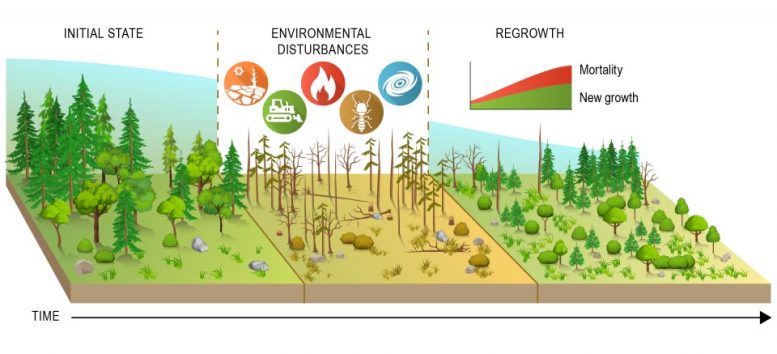
Globally, vegetative dynamics are changing. Environmental disturbances over time have negatively impacted forests, causing a deforestation loop where mortality is increasing and new growth is limited. Credit: Illustration by Nathan Johnson | PNNL
“Mortality is rising in most areas, while recruitment and growth are variable over time, leading to a net decline in the stature of forests,” said McDowell. “Unfortunately, mortality drivers like rising temperature and disturbances such as wildfire and insect outbreaks are on the rise and are expected to continue increasing in frequency and severity over the next century. So, reductions in average forest age and height are already happening and they’re likely to continue to happen.”
Vegetation dynamics are changing
The conditions promoting deforestation will likely accelerate, drastically altering the living conditions for plants and animals, McDowell said.
“Over the last hundred years we’ve lost a lot of old forests,” McDowell said.” And they’ve been replaced in part by non-forests and in part by young forests. This has consequences on biodiversity, climate mitigation, and forestry.”
Wide-ranging impact
The study also reveals that other mechanisms of deforestation—“chronically changing drivers”—are underway. They include:
- Atmospheric carbon dioxide: Carbon dioxide levels in the atmosphere have increased dramatically since the Industrial Revolution and are projected to continue rising over the next century. Higher levels of carbon dioxide can increase a tree’s growth rate and seed production. However, such carbon dioxide fertilization appears to only happen in younger forests with abundant nutrients and water. Most forests globally are exposed to limitations in nutrients and water, which drastically reduces the carbon dioxide benefits to trees.
- Temperature: Rising temperatures limit life-giving photosynthesis, leading to lower growth, higher mortality, and reduced regeneration. This is one key to shorter trees, the study determined.
- Droughts: They’re expected to increase in frequency, duration, and severity globally. Drought can directly cause tree death or indirectly lead to mortality through associated increases in insect or pathogen attack.
Other factors are altering the face of the world’s forests:
- Wildfire is increasing in many forests worldwide and future fires may be more frequent than they have been in the past 10,000 years in some regions, the study found. Plant growth following forest fires may be slow or absent due to elevated temperatures.
- Biotic deforestation disturbances—by insects, fungi, and choking vines—have been on the increase. The carbon storage lost to insects each year is the same as the amount of carbon emitted by 5 million vehicles, a study published last year says. This is expected to continue with warming, along with other biotic deforestation disturbances, such as fungi and bacteria. In the tropics, vines that use other plants as host structures are choking trees to death.
- Wood harvests alone have had a huge impact on the shift of global forests towards younger ages or towards non-forest land, reducing the number of forests, and old-growth forests, globally. Where forests are re-established on harvested land, the trees are smaller and biomass is reduced.
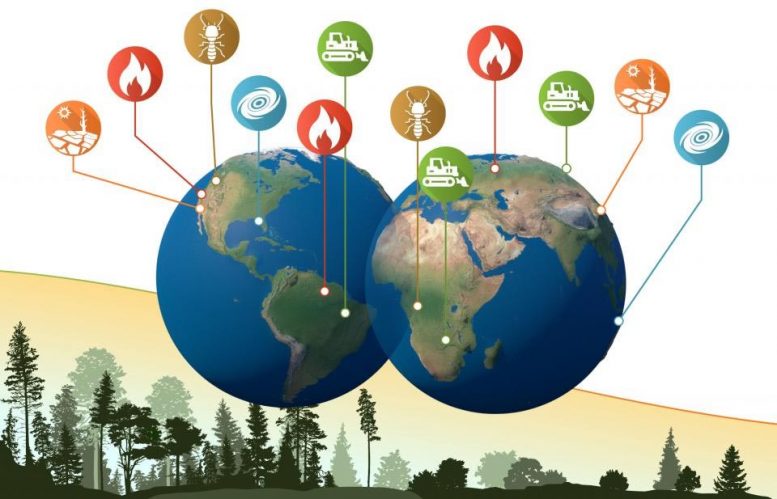
Studies around the globe show that natural and human-driven disturbances are altering the world’s forests. Credit: Illustration by Nathan Johnson | PNNL
Deforestation study born of collaboration
McDowell collaborated with more than 20 scientists to produce the deforestation study, which included data and observations made in more than 160 previous studies.
“Environmental changes are making disturbances worse, and this is causing a change in vegetation dynamics towards shorter, younger forests,” McDowell said.
Reference: “Pervasive shifts in forest dynamics in a changing world” by Nate G. McDowell, Craig D. Allen, Kristina Anderson-Teixeira, Brian H. Aukema, Ben Bond-Lamberty, Louise Chini, James S. Clark, Michael Dietze, Charlotte Grossiord, Adam Hanbury-Brown, George C. Hurtt, Robert B. Jackson, Daniel J. Johnson, Lara Kueppers, Jeremy W. Lichstein, Kiona Ogle, Benjamin Poulter, Thomas A. M. Pugh, Rupert Seidl, Monica G. Turner, Maria Uriarte, Anthony P. Walker and Chonggang Xu, 29 May 2020, Science.
DOI: 10.1126/science.aaz9463
The DOE’s Office of Science and several other organizations funded the work. The study’s authors include PNNL’s Ben Bond-Lamberty of the Joint Global Change Research Institute, and other researchers come from more than a dozen institutions, including four national laboratories: PNNL, Lawrence Berkeley, Los Alamos and Oak Ridge.
Pacific Northwest National Laboratory draws on signature capabilities in chemistry, Earth sciences and data analytics to advance scientific discovery and create solutions to the nation’s toughest challenges in energy resiliency and national security. Founded in 1965, PNNL is operated by Battelle for the U.S. Department of Energy’s Office of Science. DOE’s Office of Science is the single largest supporter of basic research in the physical sciences in the United States and is working to address some of the most pressing challenges of our time. For more information, visit PNNL’s News Center.

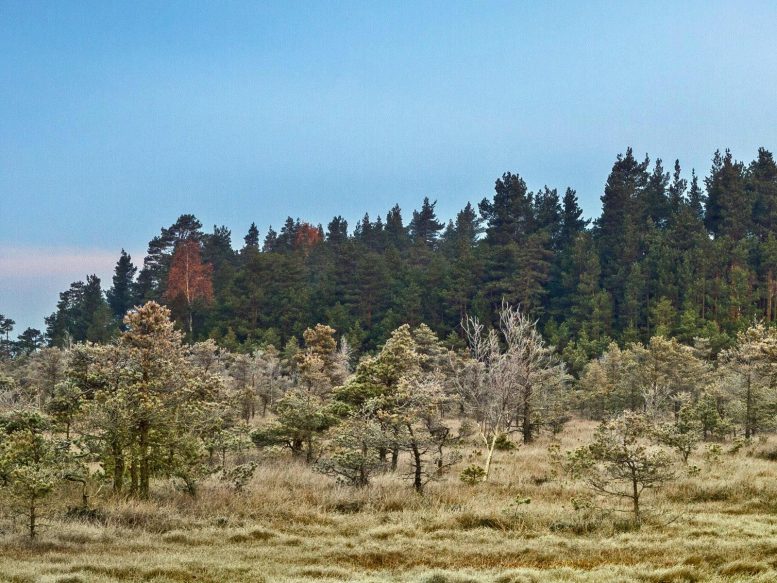
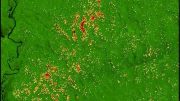


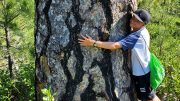

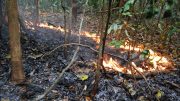


Be the first to comment on "Trees Are Getting Shorter, Younger – Changing Forest Conditions Started Decades Ago"